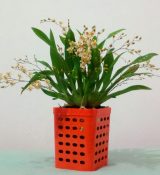Top 5 Orchids to Purchase For Your Home
Author: admin2 Comments
Blooming, Care and Culture, Growing Indoors
In this article I’ve come up with a list of the top 5 orchids to purchase for your home, based on long-lasting blooms and ease of culture. Keeping in mind the average grower has a tendency to “forget” their plants every now and again.
Top 5 Orchids to Purchase For Your Home
- Cattleyas and Mini-Cattleyas – Cattleyas are a popular choice for beginners and experts alike. These plants are very sturdy and can take a lot of abuse from those who tend to forget to water. They are also tolerant of several temperature ranges. Commonly known as the “Queen” of the orchids! Cattleyas’ are some of the showiest and most rewarding orchids for the home. The current Cattleya breeding is producing vivid colors in orange, reds, and yellows on more compact plants that bloom multiple times per year. Many of the new Cattleya hybrids are referred to as “window-sill” orchids, and have easily adapted to growing under lights and in smaller spaces.
- Phalaenopsis – One of the great things about caring for Phalaenopsis orchids is that the temperature requirements are similar to that of many homes, making it an ideal house plant. Phalaenopsis are commonly known as “Phals” or “Moth” orchids. The colors of the Phalaenopsis range from white and pinks to reds and yellows and the patterns vary from solid colors to spots, stripes, and splotches of color. Because of their long-lasting blooms and ease of culture the Phalaenopsis orchids are among the most popular orchid plants. “Phals” typically bloom during the spring with the flowers lasting for several months.
- Vandas – This particular orchid is under some serious construction; man is working with “Mother Nature” to produce some very compact, easy to grow, and even fragrant hybrids by combing Vandas with Asocentrums, Thyncostylis, Neofinetias, and other Vandas and their hybrids range from whites to greens to yellows with spots, dark raspberries, and reds to oranges, many with darker tessellations (a repeating pattern of distinct shapes) that give a spider web effect (the Vandas are truely glorious brilliant plants). The flowers range from small to huge with long and frequent bloom seasons.
- Dendrobiums – This particular orchid ranges from extremely tiny plants to plants that are over 6 feet tall. People love growing Dendrobiums because they are easy to grow and bloom, and for their graceful sprays bearing numerous flowers. Colors range from snow-whites to greens and yellows, even deep, dark maroons. Many are muti-colored and some are even fragrant! Have a habit of forgetting to water your orchids on occasion? Then this is the perfect orchid for you (Dendrobiums like this)!
- Oncidiums – Commonly known as “Dancing Ladies” and “Butterfly” orchids, Oncidiums are truly a delight to grow (producing dancing sprays of brilliant, colorful blooms). The particular Oncidiums called “Dancing Ladies” are tiny, fan-shaped equitants (having all the leaves arranged flat in one plane) or Toluminas. These small-growing Oncidiums produce some of the most incredible numbers of brightly colored and vividly patterned blooms of any ot the orchids. The “Butterfly” type of Oncidiums are referred to as Psychosis. These Oncidiums have tall spikes with flowers that resemble Monarch Butterflies.
2 Responses to “Top 5 Orchids to Purchase For Your Home”
Leave a Reply


Ask an Expert
Questions about orchids?
Our experts love a challenge!
Photo of the Week
Submit your photo to be featured on the blog!
More Photo of the Week Winners
Submit Photo








I recently received a phalaenopsis orchid plant. What type of food/fertilizer should I use? Thanks!
@ Helen Mazzoli. Apply feed at every third watering in winter, increasing to every other watering during spring and early summer. By late summer, as growths are maturing, reduce feeding to once every third watering.
Special nitrogen-or phosphate-based orchid feeds are available in granule or liquid form. According to the season, apply nitrates for growth or phosphates for flowers. Always follow manufacturer’s instructions carefully. As an alternative, you can use a standard houseplant feed diluted to half-strength.
Check out this information on Blooming Phalaenopsis Orchids.
Good luck, and happy growing!